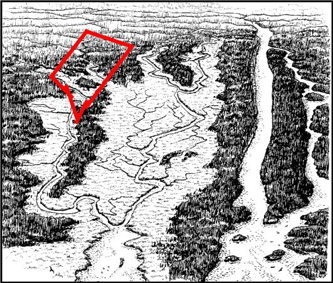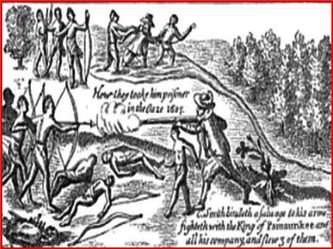Oakland History Reconsidered
Recap of Oakland History Presentation
Installment #1
By Kevin Heffernan
Mother Nature, Men Without Good Maps, the Brits, the Dutch and Indians
 The history of Oakland really begins with Mother Nature. A few billion years ago when the earth was forming, the forces of nature created the Ramapo Mountains which originally were as tall as the Alps. However, since their original formation there have been 5 Ice Ages. The ice, about 5 miles thick, literally wore them down to their current size and height in the course of advancing and receding. The same Ice Ages also created the Palisades along the Hudson River and the wide valley between known as the Pascack Valley.
The history of Oakland really begins with Mother Nature. A few billion years ago when the earth was forming, the forces of nature created the Ramapo Mountains which originally were as tall as the Alps. However, since their original formation there have been 5 Ice Ages. The ice, about 5 miles thick, literally wore them down to their current size and height in the course of advancing and receding. The same Ice Ages also created the Palisades along the Hudson River and the wide valley between known as the Pascack Valley.
Oakland’s presence in a mountain top valley limited access to the outside world and compelled the development of relatively small farms when compared to those to the East of the Ramapos to the Hudson River. The size of the farms had direct voting implications in the future and our isolation from the rest of Franklin Township had direct and specific political implications. Together these were ultimately pivotal in our road to independence as we will see in future recaps here.
Fast forward to the Dutch and the British in America in the 1600s……
The race to find a new water trade route to the Orient caused the early explorers to sail west from Europe and bump into America along the way. Think Christopher Columbus as the first. He landed to the south and claimed it for Spain. The British almost immediately in 1498 set sail to the West for the same purpose and, like Columbus, bumped into America only this time much further to the North. During the 1500s the Brits made 3 additional voyages and finally figured out that there was no water trade route to the Orient. Instead, they claimed all the land from Georgia to the West to where ever it went albeit unknown to them.
The Dutch were aware of the British land claims in America but didn’t care. They sent Henry Hudson and, like the Brits, he failed but did discover the Hudson River in 1609. By 1613, the first Dutch colony was accidentally established when a Dutch exploration ship caught fire and the passengers and crew had no way of getting home. By 1625, New Amsterdam, aka New York, was established under the auspices of the Dutch West India Company first with Peter Minuet and then ultimately with peg leg Peter Stuyvesant.
Once the Dutch figured out that they can’t go West to arrive at a land in the East, their interest then focused upon the very lucrative beaver pelt trade. Their vision was to have many small communities in a fort-like setting whose single purpose was to either trap or trade beaver pelts, not large and expanding settlements. Still, they nonetheless needed people here to execute the larger mission. For that reason, the West India Company developed a very poorly administered a patroon system to award large tracts of land in pursuit of scared beaver and trade with the Indians for same.
The arrival of the Dutch had a significant impact upon the local Indians. They introduced our native Americans to disease for which they had no immunity, cheap booze, Wampum or cheap trinkets, guns and European goods like metal axes, shovels and so forth. Indeed, the Dutch even wanted to enslave the Indians but were not at all successful.
 In spite of the fact that the official Dutch policy was to treat the local Indians well and with respect, Dutch-Indian relations turned terrible with the arrival of a new governor, Willern Kieft in 1639. During his term in office he was responsible for the killing of over 1,000 Indian men, women and children in what is known as Kieft’s War of 1643-44 in NJ and NY. The Indians struck back by killing any Dutch settler they could find in addition to taking hostages. The Dutch lost that war.
In spite of the fact that the official Dutch policy was to treat the local Indians well and with respect, Dutch-Indian relations turned terrible with the arrival of a new governor, Willern Kieft in 1639. During his term in office he was responsible for the killing of over 1,000 Indian men, women and children in what is known as Kieft’s War of 1643-44 in NJ and NY. The Indians struck back by killing any Dutch settler they could find in addition to taking hostages. The Dutch lost that war.
There was a second war against the Indians by the Dutch known as the Peach Tree War of 1655 which the Dutch also lost. In each war, the Indians killed Dutch settlers, burned their farms and held hundreds for ransom. Even after peace was established with the Indians, there was massive mutual mistrust and words like barbarians, savages and heathens entered the Dutch vocabulary to describe the Indians. Those were bad times to be a Dutch settler
When the British took control in 1664, they inherited the Dutch problems with the Indians and didn’t fare much better albeit for different reasons. Still, they somewhat got along for almost the next 100 years. It was however the property rights/land patent rights attitudes of the British that ultimately conspired against the Indians of New Jersey and Oakland. Specifically, they were forced off the land here in 1758 and compelled to move to the very first Indian reservation in America: the Brotherton Indian Reservation in the Pine Barrens of New Jersey where they languished until 1830.
To summarize, yes, once there were Indians all over the place in this valley and evidence remains with ancient burial grounds and cave dwelling places here in Oakland. But the beginning of the end of their presence here started when the Dutch colonists arrived and culminated with their exile to a reservation within 100 years. In between there were bloody wars and massacres creating an atmosphere of mutual hatred with an overlay of forced interdependence.
Kevin Heffernan – kheffernan555@gmail.com

Love reading your article. It is a lot that I did not know. Look forward to reading more. Great work Kevin.
Very interesting. Looking forward to the rest of the story. I read somewhere that some of Lenni Lenapes from Franklin Township, NJ were exiled to Stockbridge NY, south of Oneida Lake.
Loved this article. Very interesting and informative. It is always sad when read that a proud nation was driven to almost extinction because of greed and the thought to be superiority of another nation. But, hasn’t it been that way throughout history!?
Keep giving us more local history lessons. LOVE THEM!